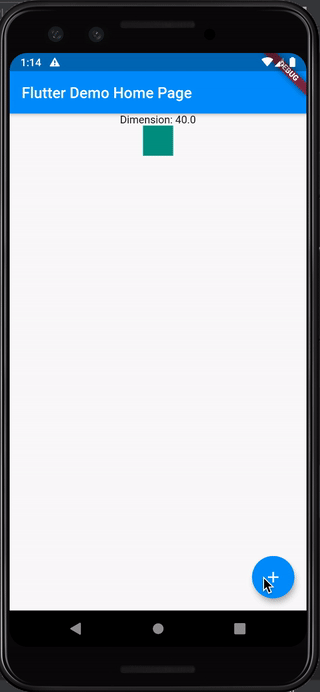How to get height of a Widget?
This is (I think) the most straightforward way to do this.
Copy-paste the following into your project.
UPDATE: using RenderProxyBox results in a slightly more correct implementation, because it's called on every rebuild of the child and its descendants, which is not always the case for the top-level build() method.
NOTE: This is not exactly an efficient way to do this, as pointed by Hixie here. But it is the easiest.
import 'package:flutter/material.dart';
import 'package:flutter/rendering.dart';
typedef void OnWidgetSizeChange(Size size);
class MeasureSizeRenderObject extends RenderProxyBox {
Size? oldSize;
final OnWidgetSizeChange onChange;
MeasureSizeRenderObject(this.onChange);
@override
void performLayout() {
super.performLayout();
Size newSize = child!.size;
if (oldSize == newSize) return;
oldSize = newSize;
WidgetsBinding.instance!.addPostFrameCallback((_) {
onChange(newSize);
});
}
}
class MeasureSize extends SingleChildRenderObjectWidget {
final OnWidgetSizeChange onChange;
const MeasureSize({
Key? key,
required this.onChange,
required Widget child,
}) : super(key: key, child: child);
@override
RenderObject createRenderObject(BuildContext context) {
return MeasureSizeRenderObject(onChange);
}
}
Then, simply wrap the widget whose size you would like to measure with MeasureSize.
var myChildSize = Size.zero;
Widget build(BuildContext context) {
return ...(
child: MeasureSize(
onChange: (size) {
setState(() {
myChildSize = size;
});
},
child: ...
),
);
}
So yes, the size of the parent cannot can depend on the size of the child if you try hard enough.
Personal anecdote - This is handy for restricting the size of widgets like Align, which likes to take up an absurd amount of space.
To get the size/position of a widget on screen, you can use GlobalKey to get its BuildContext to then find the RenderBox of that specific widget, which will contain its global position and rendered size.
Just one thing to be careful of: That context may not exist if the widget is not rendered. Which can cause a problem with ListView as widgets are rendered only if they are potentially visible.
Another problem is that you can't get a widget's RenderBox during build call as the widget hasn't been rendered yet.
But what if I need to get the size during the build! What can I do?
There's one cool widget that can help: Overlay and its OverlayEntry.
They are used to display widgets on top of everything else (similar to stack).
But the coolest thing is that they are on a different build flow; they are built after regular widgets.
That have one super cool implication: OverlayEntry can have a size that depends on widgets of the actual widget tree.
Okay. But don't OverlayEntry requires to be rebuilt manually?
Yes, they do. But there's another thing to be aware of: ScrollController, passed to a Scrollable, is a listenable similar to AnimationController.
Which means you could combine an AnimatedBuilder with a ScrollController, it would have the lovely effect to rebuild your widget automatically on a scroll. Perfect for this situation, right?
Combining everything into an example:
In the following example, you'll see an overlay that follows a widget inside ListView and shares the same height.
import 'package:flutter/material.dart';
import 'package:flutter/scheduler.dart';
class MyHomePage extends StatefulWidget {
const MyHomePage({Key key, this.title}) : super(key: key);
final String title;
@override
_MyHomePageState createState() => _MyHomePageState();
}
class _MyHomePageState extends State<MyHomePage> {
final controller = ScrollController();
OverlayEntry sticky;
GlobalKey stickyKey = GlobalKey();
@override
void initState() {
if (sticky != null) {
sticky.remove();
}
sticky = OverlayEntry(
builder: (context) => stickyBuilder(context),
);
SchedulerBinding.instance.addPostFrameCallback((_) {
Overlay.of(context).insert(sticky);
});
super.initState();
}
@override
void dispose() {
sticky.remove();
super.dispose();
}
@override
Widget build(BuildContext context) {
return Scaffold(
body: ListView.builder(
controller: controller,
itemBuilder: (context, index) {
if (index == 6) {
return Container(
key: stickyKey,
height: 100.0,
color: Colors.green,
child: const Text("I'm fat"),
);
}
return ListTile(
title: Text(
'Hello $index',
style: const TextStyle(color: Colors.white),
),
);
},
),
);
}
Widget stickyBuilder(BuildContext context) {
return AnimatedBuilder(
animation: controller,
builder: (_,Widget child) {
final keyContext = stickyKey.currentContext;
if (keyContext != null) {
// widget is visible
final box = keyContext.findRenderObject() as RenderBox;
final pos = box.localToGlobal(Offset.zero);
return Positioned(
top: pos.dy + box.size.height,
left: 50.0,
right: 50.0,
height: box.size.height,
child: Material(
child: Container(
alignment: Alignment.center,
color: Colors.purple,
child: const Text("^ Nah I think you're okay"),
),
),
);
}
return Container();
},
);
}
}
Note:
When navigating to a different screen, call following otherwise sticky would stay visible.
sticky.remove();
Here's a sample on how you can use LayoutBuilder to determine the widget's size.
Since LayoutBuilder widget is able to determine its parent widget's constraints, one of its use case is to be able to have its child widgets adapt to their parent's dimensions.
import 'package:flutter/material.dart';
void main() {
runApp(MyApp());
}
class MyApp extends StatelessWidget {
@override
Widget build(BuildContext context) {
return MaterialApp(
title: 'Flutter Demo',
theme: ThemeData(
visualDensity: VisualDensity.adaptivePlatformDensity,
),
home: MyHomePage(title: 'Flutter Demo Home Page'),
);
}
}
class MyHomePage extends StatefulWidget {
MyHomePage({Key key, this.title}) : super(key: key);
final String title;
@override
_MyHomePageState createState() => _MyHomePageState();
}
class _MyHomePageState extends State<MyHomePage> {
var dimension = 40.0;
increaseWidgetSize() {
setState(() {
dimension += 20;
});
}
@override
Widget build(BuildContext context) {
return Scaffold(
appBar: AppBar(
title: Text(widget.title),
),
body: Center(
child: Column(children: <Widget>[
Text('Dimension: $dimension'),
Container(
color: Colors.teal,
alignment: Alignment.center,
height: dimension,
width: dimension,
// LayoutBuilder inherits its parent widget's dimension. In this case, the Container in teal
child: LayoutBuilder(builder: (context, constraints) {
debugPrint('Max height: ${constraints.maxHeight}, max width: ${constraints.maxWidth}');
return Container(); // create function here to adapt to the parent widget's constraints
}),
),
]),
),
floatingActionButton: FloatingActionButton(
onPressed: increaseWidgetSize,
tooltip: 'Increment',
child: Icon(Icons.add),
),
);
}
}
Demo

Logs
I/flutter (26712): Max height: 40.0, max width: 40.0
I/flutter (26712): Max height: 60.0, max width: 60.0
I/flutter (26712): Max height: 80.0, max width: 80.0
I/flutter (26712): Max height: 100.0, max width: 100.0
Update: You can also use MediaQuery to achieve similar function.
@override
Widget build(BuildContext context) {
var screenSize = MediaQuery.of(context).size ;
if (screenSize.width > layoutSize){
return Widget();
} else {
return Widget(); /// Widget if doesn't match the size
}
}